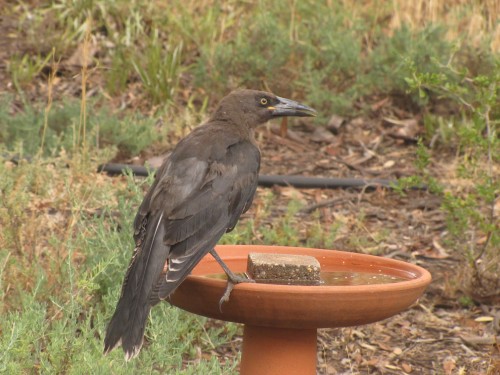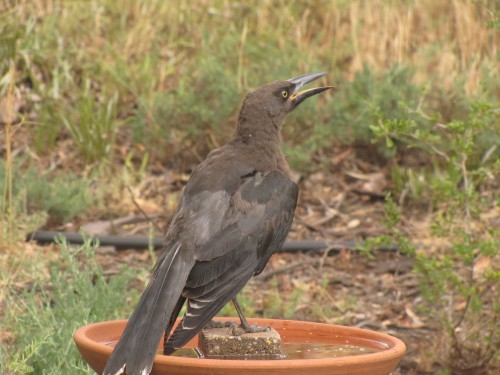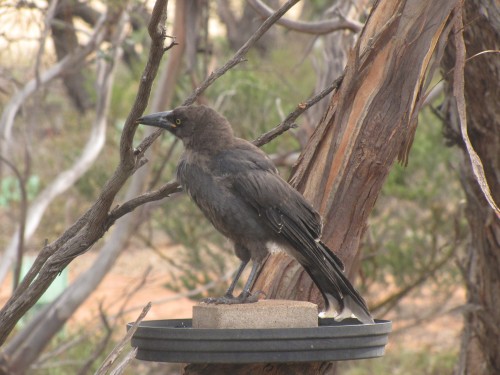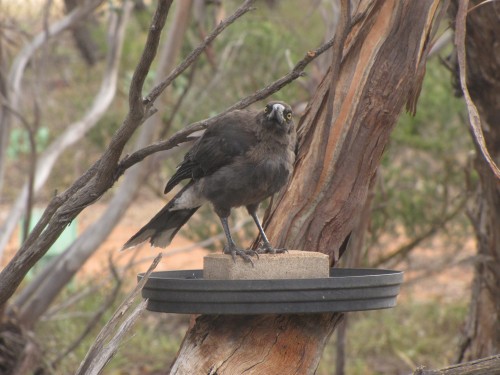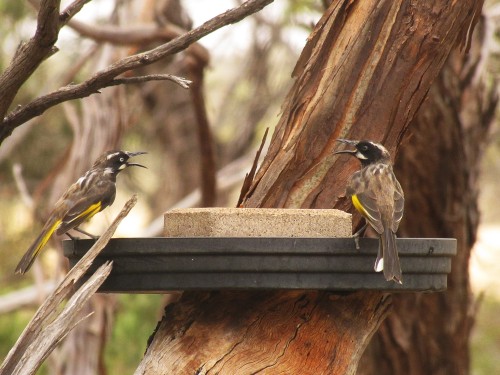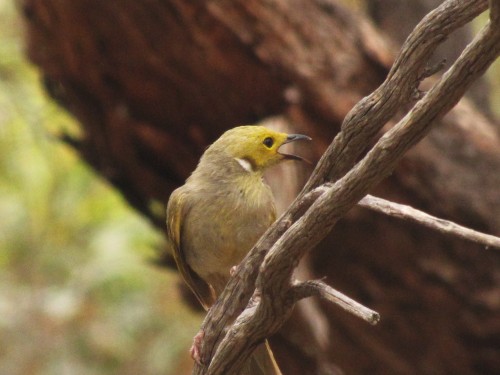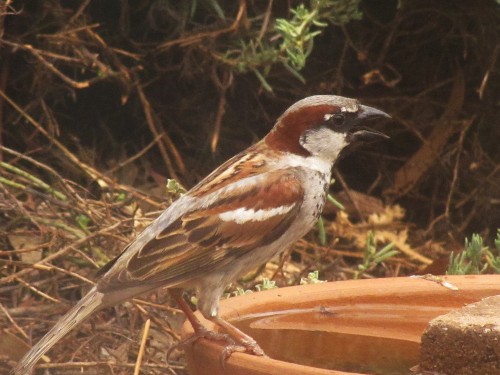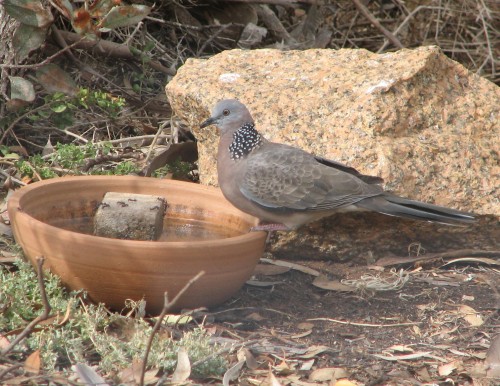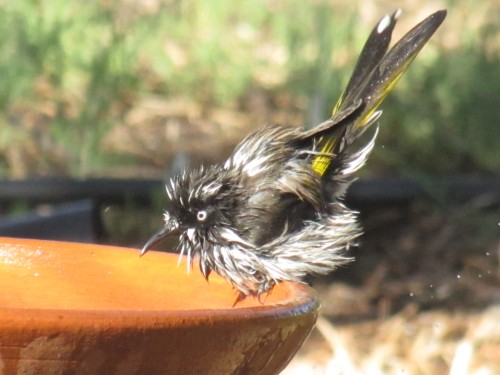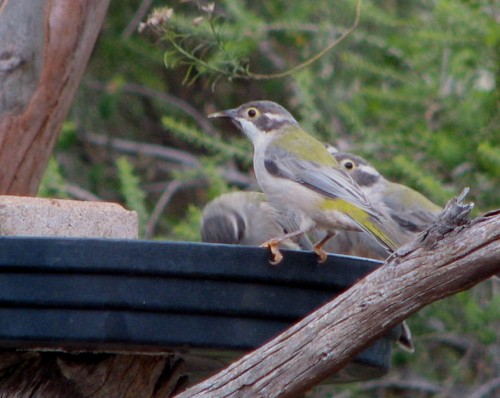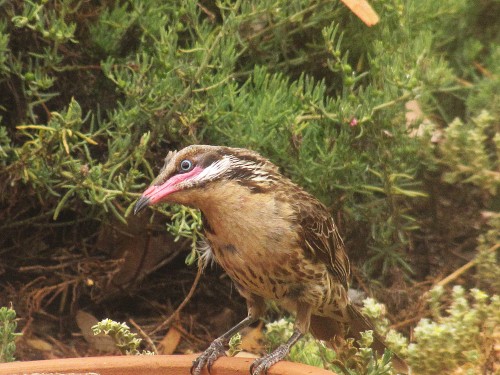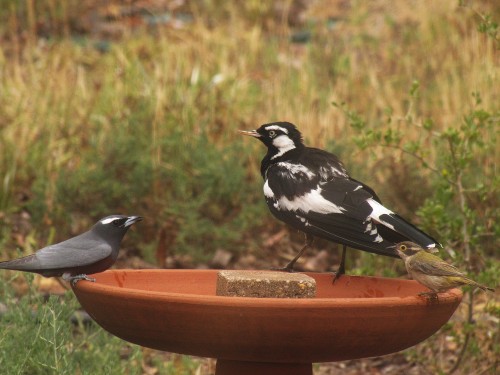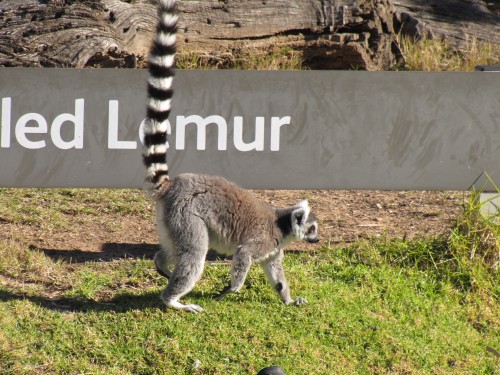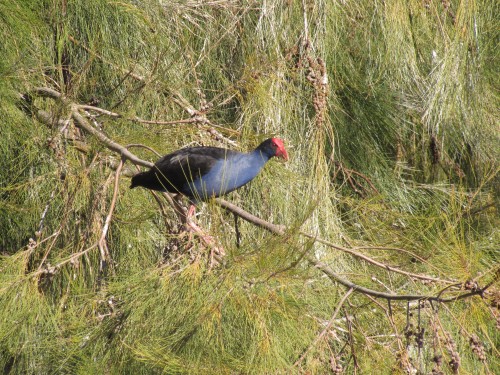Hot weather birding
Over recent posts I have written about the very hot conditions we have had here in South Australia this summer. I won’t bore you by stating the obvious yet again. When the weather gets much over 30C (86F) I tend not to go out birding, though I have on occasions been out in much hotter weather.
When the temperature soars here in Murray Bridge (80 km SE of Adelaide) I tend to stay indoors as much as possible. It is one of the joys of being ‘retired’. On these occasions we have the delight of a constant stream of birds coming to our bird baths. These containers are strategically placed in our garden where we can observe – and photograph – the birds at our leisure. On very hot days like we have had over recent months the stream has sometimes been a flood.
When the Grey Currawongs come to drink, most of the smaller birds keep their distance. I am not surprised by this; the Currawong’s bill and head is about the size of birds like the thornbills or the wrens. I guess that the smaller species know instinctively that the Currawong is capable of raiding their nests for eggs and baby birds, and so they remain at a respectful distance while the bigger birds are drinking.
During one of our recent hot spells this juvenile Grey Currawong came for a drink. I can tell that it is a young one not long out of the nest because of the downy feathers, as well as the yellow gap on the bill. Only a few days before these photos were taken I saw the juveniles being fed by the adults.
Once the Currawong had finished drinking, the smaller birds quickly returned.
Birds in the heat
Here in South Australia we are experiencing our hottest summer on record. I won’t bore you with the details, but just say that we have had far too many days in the 40s (45C is equal to 113F). During such heatwaves – which can last for several days – our bird population suffers terribly. On these days the resident birds in our garden really appreciate the various bird baths we have placed in suitable locations.
Even on a warm day we get a constant parade of birds visiting the various bird baths in our garden. Our sun room overlooks several of them and this affords me an ideal location to take photos of them. Some birds still visit the water even on quite cold days – but we haven’t had many of those lately.
Probably the most common visitors would have to be the honeyeater species, including:
- Red Wattlebirds,
- White-plumed honeyeaters,
- New Holland Honeyeaters,
- Brown-headed Honeyeaters
- Singing Honeyeaters
- Spiny-cheeked Honeyeaters
Other regular visitors include:
- Australian Magpies
- White-winged Choughs
- Grey Currawong
- Australian Magpie Larks
- Crested Pigeons
- Spotted Turtledove
- Striated Pardalote
- Spotted Pardalote
- Silvereyes
- House Sparrow
- Common Starling
- Common Blackbird
The importance of water to birds
I love getting comments from my readers. Every now and then I get a really interesting one, like the one from Sue which I have quoted below.
Happy new year Trevor!
A Big thank you for maintaining your site…
I’m in suburban Adelaide, and I put a second bath into the garden when the hot weather struck early in the season. We have always had a terracotta pot pond with water lilies that allows for the bees to drink as well having a strong enough rim for some of the larger birds. The other two are just very large terracotta pot saucers, one on the ground, the other now in a raised garden bed under a deep shade tree.The ring neck dove (Spotted Turtle-dove) nested and fledged a chick in a hanging pot under the verandah.. Much cooler than her previous nest . Blackbird got it wrong and build a nest behind the fence post on the support rail .. But the iron faces west and is only shaded part of the day. She sat the nest for a full week before abandoning it, I suspect it was far too hot once the sun tracked round. Unfortunately, mid year, the neighbours had removed the large shrubs many of them had been using.
The New Holland honeyeaters, the Blackbird and the Wattlebirds have all now learnt to associate me out watering with a wet foliage cool off. The honeyeaters will actually make a fuss until I wet the bamboo down to make a cool and safe retreat then happily make use of it regardless of how close I am.
I suspect they may nest in the bamboo next year as its big enough to be a stable thicket.
All of them love it when the old fashioned rain wave sprinkler is put on.
They all seem to be learning new tricks to cope with the extra heat … with a little help from their friends.
Cheers
Sue.
Thank you, Sue, for sharing your delight in the birds in your garden.
If any of my readers would like to also share their experiences with birds in gardens – or other places for that matter, please leave a comment here on this article, or any article for that matter. You never know – I may feature your experiences in an article so everyone can read it.
Below I have included a few photos of birds at our bird baths.
Good birding,
Trevor.
Further reading:
- Time for a bath – an article about birds and other animals which have visited our bird baths.
Give the birds a treat for Christmas
Merry Christmas Everyone
I wish all of my readers a very merry and blessed Christmas, wherever you are.
I would be really pleased to get greetings from you – just use the “comments” section above.
Birds in the hot Australian sun:
Many parts of Australia are in the grips of an early, very hot summer, and this is especially so here in South Australia. Our capital city of Adelaide last week had a record December heatwave for over a hundred years with a string of 4 days over 40C. Yesterday was another very hot day at around 37C and today, Christmas Day, the forecast is for 38C. This will make it the hottest Christmas Day since 1945.
During hot conditions like these our birds suffer terribly. All of my Australian readers – and readers everywhere suffering in the hot, summer sun – I would like to encourage to buy a bird bath for their garden. Even putting a few old bowls or dishes of water around the garden is better than nothing.
We have had three bird baths strategically placed in our garden for many years. These have been placed so that we can watch from the room which we use the most. Many of the photos which I have used on this site were taken from that room, including that of a Spiny-cheeked Honeyeater shown above, and taken in the heatwave last week..
Two days ago our daughter arrived home for the Christmas break and doubled our number of bird baths. Our children have given us three new bird baths. I hope this doubles the number of photos I can take!
I hope that you have a great Christmas and a wonderful New Year.
Trevor
Further reading:
- Spiny-cheeked honeyeater on a hot day
- Make room for me – White-winged Choughs get a little crowded at the bird bath
- Time for a bath – a list of bird and non-bird visitors to our bird baths
A swamphen and some lemurs
Over the last few weeks I have been sharing photos of some of the birds I saw while visiting the Western Plains Zoo in Dubbo, NSW. On another occasion I commented that all of the birds seen in the zoo are actually birds that are free and not part of the exhibits. I also commented that many of these birds have adapted to the feeding times of the various animals – a free feed, so to speak.
The Purple Swamphen (see photo below) is one such bird. It was skulking around, perched on a flimsy branch of a tree, waiting for the Ring-tailed Lemurs (see photo above) to finish eating their dinner.
